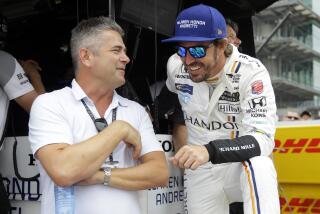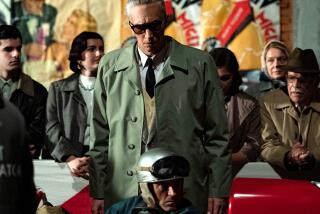Being McQueen for a day
MONTEREY, CALIF. -- For sale: 1963 Ferrari 250 GT Berlinetta Lusso, 56,000-plus original miles, once owned by Steve McQueen, perfect condition, brown.
Brown?
“It’s not my favorite color,” admits Mike Regalia, the Thousand Oaks auto restorer whose car is the star of this week’s Christie’s auction in Monterey. “But Steve loved brown.” The Lusso -- a gift from McQueen’s first wife, Neile Adams -- was special-ordered from Otto Zipper Motors on Wilshire Boulevard with the “Marrone” paint job, which is what the Ferrari factory called the deep chestnut hue. “Actually,” Regalia says with a smile, “it’s a very elegant color.”
Or colors. When Regalia, 52, pushes the Ferrari out of a storage facility into the Monterey sunlight, the metallic paint ignites with a pale opalescent fire, shimmering in shades of honey and oxblood. Imagine a Ferrari-shaped pool filled with ancient brandy. The Lusso, designed by the famed Italian coachworks Pininfarina, is regarded as one of the loveliest of Ferrari’s touring cars, but no Lusso ever left the factory with half the hand-rubbed luster this car has. “I’ve got 2,000 man-hours in the paint alone,” says Regalia.
Will the Lusso shine as brightly when it’s pushed under the lights at the Monterey Jet Center on Thursday? That’s the million-dollar question, or maybe $2 million. After all, there’s a lot of money out there. The euro is huge against the dollar, and the thickets are filled with hedge-fund millionaires looking to diversify their investments while Wall Street wobbles. As the world’s car-collecting elite gather on the peninsula before Sunday’s Pebble Beach Concours d’Elegance, the Lusso is being eyed as a bellwether of the vintage car market, which in some quarters is experiencing a kind of crazed exuberance not seen since the boom-bust days of the early 1990s.
The McQueen Lusso is “the first important car for sale this week,” says Ken Gross, automotive historian and authority on the vintage car market. “People will be watching to see what it sells for. If it does well, other cars will do better. If it falls really flat, there’ll be a buzz about that. That car will set the tone for the whole weekend.”
The Lusso sale will also index to the state of Steve McQueen’s legend. The actor, who died in 1980 at age 50 from surgical complications after a diagnosis of mesothelioma, has emerged as a bona fide icon of automotive culture. Not only was McQueen a talented driver, rider and racer -- he won his class at the 12 Hours of Sebring in 1970 -- he was, as an actor and producer, responsible for some of the most beloved cult films of autodom, including the weirdly wonderful “Le Mans,” in 1971, a movie that does for racing fans what “The Devil Wears Prada” does for shoe fetishists.
“Everything Steve McQueen is hot, hot, hot,” says Dick Messer, director of the Petersen Automotive Museum. In November the museum hosted an auction of McQueen-related cars, motorcycles and personal effects. An ordinary pair of Persol sunglasses -- alleged to be the pair McQueen wore in “The Thomas Crown Affair” -- sold for $70,200.
“It was otherworldly,” says Messer. “You thought you were in a dream as far as prices were concerned.”
The McQueen Lusso finds itself “at a convergence of two tidal waves,” says Keith Martin, publisher of Sports Car Market magazine. “On one side is the fascination with Steve McQueen, and the other is the market for fine 12-cylinder Ferraris.”
And somewhere in the mix is Mike Regalia, trying not to think about what the car might bring. “I’m not a wealthy man,” says Regalia, who bought the car for “under $100,000” and has devoted about 4,000 hours to turning it into the showpiece it is. “This car is the culmination of a lifetime of buying and fixing up and selling cars.”
Any other Lusso like Regalia’s is worth about $500,000 on the open market. Regalia recently turned down an offer from the Petersen for $750,000. “The real unquantifiable is Steve McQueen,” he says. “He was a cool guy, it’s a cool car and it’s got a cool story,” he says. On Thursday, “The market can decide what that’s worth.”
--
With some small degree of apprehension, Regalia agrees to let me drive the McQueen Lusso. It is, first of all, as close to perfection as automobiles get. Every shut line -- where hood and doors and trunk and fenders come together -- is dead even down to the millimeter. The chrome sparks with sunshine. Unlike modern production cars, whose machine-applied paint has an orange-rind texture, the Lusso’s paint is as smooth as Murano glass, flowing from the brilliant chrome fascia to the distinctive tapered tail, the “Kammback.” This is fit and finish the Scaglietti factory -- where the body was built -- could only dream about.
The door swings open with an easy balance and I park myself behind the wood-rimmed steering wheel, trying to imagine what McQueen must have thought of the car. McQueen, whose height was variously reported between 5 feet 7 and 5 feet 10, would have been comfortable in the car, but at 6 feet 1, I have a bit of a legroom issue.
Unlike a modern car that has no scent of machinery about it, the Lusso is delectably perfumed with the smell of leather, fuel and oil. The whiteface gauges are as bright as a Hollywood smile. Every finish screw holding the door trim has been selected so that the screw slot is perfectly horizontal. “You just keep trying screws until you find one that lines up,” says Regalia.
Built on the Ferrari 250 GT SWB (short wheelbase) chassis, the Lusso is a luxurious car, particularly for Ferrari. “Lusso” means “luxury” in Italian. The interior is wrapped in meticulously stitched leather -- black leather on the dash and crema-colored leather on the seats, doors and transmission tunnel. The leather on the parcel shelf in the rear is quilted, as was the fashion for these cars.
One clue that the Lusso is not as driver-focused as other Ferraris is that the speedometer and tachometer are in the center of the dash and not behind the wheel.
“Steve didn’t consider it a sports car,” says William Claxton, a close friend of the actor at the time. “He thought of it as a gran turismo.”
And yet, it’s still plenty sporty. With a twist of the key (the ignition, like a Porsche’s, is situated to the left of the wheel) the 3-liter V12 lights with vintage grind-cough before settling into a mellow, reverberant idle. Rapping the throttle evokes a hot, open-throat cackle from the quad exhaust. “Don’t feather the clutch,” Regalia warns. “In or out.”
After some delicate moments getting over speed bumps -- the exhaust system is perilously close to the ground -- we wheel the Lusso onto a highway. The long hood swings like the prow of a boat as we turn. With no power steering, the Lusso demands a higher energy output from the driver, but its controls are fluid and precise, with none of the empty slack in the steering that cars of this era were known for. The power-boosted brakes (four-wheel discs) haul the car down from speed, the pedal offering hard hydraulic feedback all but unknown in modern cars.
“The Lusso was always my absolute favorite Ferrari,” says Regalia. He bought the car from San Francisco collector Tom Sherwood in 1997 after two years of negotiation -- Regalia had to throw in a rare pistol to seal the deal. “I didn’t really think about the McQueen connection,” he says. “I bought it because it was a good, unrestored car. It wasn’t until I got it home and sat behind the wheel that I thought, ‘Whoa, this is a different situation here.’ ”
The Ferrari was one of Regalia’s daily drivers until 2000, when he decided to pull it apart and restore it. As the former director of restoration at the Nethercutt Collection in Sylmar -- Regalia left as president in 2005 -- he had all the skills required to bring the car back to its full glory. He completed the restoration in 2005.
“That’s probably the best Lusso in the world,” says the Petersen museum’s Messer. “Mike Regalia’s reputation is top notch.”
At 2,900 pounds and with 240 horsepower, the car is by no means overpowered. It’s also geared quite tall, which is to say the ratios in the four-speed transmission and differential favor high-speed cruising more than off-the-line acceleration. Puttering from stoplight to stop sign, it’s difficult not to lug the engine at low speeds. Stalling the engine is a sure way not to look like McQueen.
But then the route opens up. I cut my eyes to the right to glance at the tach as I roll on the throttle, steadily closing on the 7,500-rpm redline. The engine warbles. I expect Regalia to wince but he seems serene. Clearing a lazy bend on a back road, I upshift to third and the car catches a billowing updraft of old-fashioned torque.
Here it is, my moment of Steve, behind the wheel of his old Ferrari on a sun-damasked country lane, the V12 pounding away, a snarling exhaust in the wind. It’s not the sensual pleasures of driving the Ferrari that will reward the next owner, considerable though they may be. It will be this moment of kinship with the actor over the decades, with the car as the medium.
Where did I put my Persol sunglasses?
--
There are several ironies in the story of the McQueen Lusso. The first is that McQueen, an ardent anti-establishment type, should have his old car caught up in the big-money, collector car establishment, as embodied by Christie’s elaborate PR campaign around the Lusso. “I think he’d probably find it all pretty funny,” says his friend Claxton. “He’d probably say, ‘Do they want my old underwear, my dirty socks?’ ” (Answer: Yes!)
--
There’s also some question about McQueen’s affection for the car. Chad McQueen, the actor’s son, remembers the car disappearing from his dad’s collection after only about three years and not the 10 years asserted by Christie’s. The Lusso was by no means McQueen’s favorite car. “My dad had a lot of favorite cars,” says McQueen. Such is the fickleness of a real car guy.
The relationship between celebrity provenance and value is problematic. Much depends on which celebrity. On Friday, for instance, Bonhams & Butterfields is auctioning off a Jaguar once owned by singer Lena Horne, but nobody expects her ownership to command much of a premium over market value. It’s not simply a matter of a star’s luminosity, Messer says. “It’s got to resonate.” People have been burned speculating on cars once owned by Frank Sinatra and Elvis Presley.
“McQueen is not your average celebrity,” says Christopher Sanger, vice president of Christie’s and head of U.S. sales of automobiles. “From his movie work to his personal life, he was synonymous with cars, horsepower, racing.”
And McQueen’s stock is rising. According to Martin Cribbs, director of rights representation for Corbis, which manages the actor’s image and likeness for his heir, McQueen is one of the firm’s top 10 earning accounts and, in terms of requests, among the top three, which puts the unlettered McQueen right up there with Einstein.
“We’re amazed at the growing popularity of McQueen,” Cribbs says, “not just domestically but worldwide.” McQueen has been summoned from beyond to sell Tag Heuer watches, Absolut Vodka and, perhaps most famously, Ford Pumas and Mustangs, in commercials where the actor was digitally rematerialized behind the wheel.
“McQueen was the real deal,” says Cribbs. “It’s that authenticity that comes across to people, that means something. McQueen stands for something larger than just being an actor.”
The McQueen Lusso, Christie’s Sanger says, is really the perfect auction car “because it has all these intangibles associated with it. It’s the sort of thing that helps folks part with more money than a Lusso would otherwise be worth.”
Regalia hopes so. “The bigger the number for this car, the bigger the celebrity the car itself becomes,” he says. “This isn’t the end of this car’s story. It’s the beginning.”






